On the Capabilities of the IREA-CNR Airborne SAR Infrastructure
Abstract
:1. Introduction
2. Materials and Methods
2.1. The Flight Segment
2.2. The Ground Segment
2.2.1. IT Platform
2.2.2. Laboratory Activities
Measurement of the Antenna Patterns
Measurement of the Antenna Phase Center (APC) Position
2.2.3. In Situ Activities
Assembly and Disassembly of the SAR Sensor Onboard the Aircraft
Deployment of Corner Reflectors (CRs)
Measurement of CR Positions
Measurement of Antenna Lever Arms
Data Download and Transfer
2.2.4. SAR Data Processing Chain
- a single Computing Element (CE) acting as a master node in terms of job scheduling policy control;
- several Worker Nodes (WNs) ensuring the required computation capability, particularly to execute data processing steps based on a parallel programming strategy;
- several Storage Elements (SEs) that are installed to store the data.
SAR Focusing
- (a)
- processing of the navigation data;
- (b)
- Range Compression (RC) of the radar data;
- (c)
- Radio Frequency Interference (RFI) detection and removal at the range-compressed data level;
- (d)
- Azimuth Compression (AC) of the radar data.
- (a)
- Processing of the navigation data
- (b)
- Range Compression (RC) of the radar data
- (c)
- Radio Frequency Interference (RFI) detection and removal
- (d)
- Azimuth Compression (AC) of the radar data
Higher-Level Products
- (a)
- External Radiometric Calibration
- (b)
- Polarimetric Processing
- (c)
- Interferometric Processing
3. Results
4. Discussion
Future Perspectives
5. Conclusions
Author Contributions
Funding
Data Availability Statement
Conflicts of Interest
References
- Franceschetti, G.; Lanari, R. Synthetic Aperture Radar Processing; CRC: Boca Raton, FL, USA, 1999. [Google Scholar]
- Moreira, A.; Prats-Iraola, P.; Younis, M.; Krieger, G.; Hajnsek, I.; Papathanassiou, K.P. A tutorial on Synthetic Aperture Radar. IEEE Geosci. Remote Sens. Mag. 2013, 1, 6–43. [Google Scholar] [CrossRef]
- Lee, J.; Pottier, E. Polarimetric Radar Imaging: From Basics to Applications; CRC Press: New York, NY, USA, 2009. [Google Scholar]
- Bamler, R.; Hartl, P. Synthetic aperture radar interferometry. Inverse Probl. 1998, 14, R1–R54. [Google Scholar] [CrossRef]
- Massonnet, D.; Rossi, M.; Carmona, C.; Adragna, F.; Peltzer, G.; Feigl, K.; Rabaute, T. The displacement field of the Landers earthquake mapped by radar interferometry. Nature 1993, 364, 138–142. [Google Scholar] [CrossRef]
- Available online: https://www.asi.it/en/earth-science/cosmo-skymed/ (accessed on 20 August 2024).
- Available online: https://www.esa.int/Applications/Observing_the_Earth/Copernicus/Sentinel-1 (accessed on 20 August 2024).
- Available online: https://www.esa.int/Applications/Observing_the_Earth/FutureEO/ESA_selects_Harmony_as_tenth_Earth_Explorer_mission (accessed on 20 August 2024).
- Available online: https://www.esa.int/Applications/Observing_the_Earth/Copernicus/Contract_signed_for_new_Copernicus_ROSE-L_mission (accessed on 20 August 2024).
- Available online: https://www.capellaspace.com/ (accessed on 20 August 2024).
- Available online: https://www.iceye.com/ (accessed on 20 August 2024).
- Available online: https://metasensing.com/ (accessed on 20 August 2024).
- Krieger, G.; Moreira, A.; Fiedler, H.; Hajnsek, I.; Werner, M.; Younis, M.; Zink, M. TanDEM-X: A Satellite Formation for High-Resolution SAR Interferometry. IEEE Trans. Geosci. Remote Sens. 2007, 45, 3317–3341. [Google Scholar] [CrossRef]
- Torre, A.; Calabrese, D.; Porfilio, M. COSMO-SkyMed: Image quality achievements. In Proceedings of the 5th International Conference on Recent Advances in Space Technologies—RAST2011, Istanbal, Turkey, 9–11 June 2011. [Google Scholar]
- Roa, Y.; Rosell, P.; Solarte, A.; Euillades, L.; Carballo, F.; García, S.; Euillades, P. First assessment of the interferometric capabilities of SAOCOM-1A: New results over the Domuyo Volcano, Neuquén Argentina. J. South Am. Earth Sci. 2021, 106, 102882. [Google Scholar] [CrossRef]
- Kellogg, K.; Hoffman, P.; Standley, S.; Shaffer, S.; Rosen, P.; Edelstein, W.; Dunn, C.; Baker, C.; Barela, P.; Shen, Y.; et al. NASA-ISRO Synthetic Aperture Radar (NISAR) Mission. In Proceedings of the 2020 IEEE Aerospace Conference, Big Sky, MT, USA, 7–14 March 2020; pp. 1–21. [Google Scholar] [CrossRef]
- Davidson, M.W.J.; Furnell, R. ROSE-L: Copernicus L-Band Sar Mission. In Proceedings of the 2021 IEEE International Geoscience and Remote Sensing Symposium IGARSS, Brussels, Belgium, 11–16 July 2021; pp. 872–873. [Google Scholar] [CrossRef]
- Baqué, R.; Bonin, G.; du Plessis, O.R. The airborne SAR-system: SETHI airborne microwave remote sensing imaging system. In Proceedings of the 7th European Conference on Synthetic Aperture Radar, Friedrichshafen, Germany, 2–5 June 2008. [Google Scholar]
- Ruault du Plessis, O.; Nouvel, J.; Baque, R.; Bonin, G.; Dreuillet, P.; Coulombaix, C.; Oriot, H. ONERA SAR facilities. IEEE Aerosp. Electron. Syst. Mag. 2011, 26, 24–30. [Google Scholar] [CrossRef]
- Magnard, C.; Frioud, M.; Small, D.; Brehm, T.; Essen, H.; Meier, E. Processing of MEMPHIS Ka-Band Multibaseline Interferometric SAR Data: From Raw Data to Digital Surface Models. IEEE J. Sel. Top. Appl. Earth Observ. Remote Sens. 2014, 7, 2927–2941. [Google Scholar] [CrossRef]
- Esposito, C.; Natale, A.; Palmese, G.; Berardino, P.; Lanari, R.; Perna, S. On the Capabilities of the Italian Airborne FMCW AXIS InSAR System. Remote Sens. 2020, 12, 539. [Google Scholar] [CrossRef]
- Horn, R.; Nottensteiner, A.; Reigber, A.; Fischer, J.; Scheiber, R. F-SAR—DLR’s new multifrequency polarimetric airborne SAR. In Proceedings of the International Geoscience and Remote Sensing Symposium, Cape Town, South Africa, 12–17 July 2009. [Google Scholar]
- Perna, S.; Esposito, C.; Amaral, T.; Berardino, P.; Jackson, G.; Moreira, J.; Pauciullo, A.; Vaz Junior, E.; Wimmer, C.; Lanari, R. The InSAeS4 airborne X-band interferometric SAR system: A first assesment on its imaging and topographic mapping capabilities. Remote Sens. 2016, 8, 40. [Google Scholar] [CrossRef]
- Perna, S.; Alberti, G.; Berardino, P.; Bruzzone, L.; Califano, D.; Catapano, I.; Ciofaniello, L.; Donini, E.; Esposito, C.; Facchinetti, C.; et al. The ASI Integrated Sounder-SAR System Operating in the UHF-VHF Bands: First Results of the 2018 Helicopter-Borne Morocco Desert Campaign. Remote Sens. 2019, 11, 1845. [Google Scholar] [CrossRef]
- Aguasca, A.; Acevo-Herrera, R.; Broquetas, A.; Mallorqui, J.J.; Fabregas, X. ARBRES: Light-Weight CW/FM SAR Sensors for Small UAVs. Sensors 2013, 13, 3204–3216. [Google Scholar] [CrossRef] [PubMed]
- Luebeck, D.; Wimmer, C.; Moreira, L.F.; Alcântara, M.; Oré, G.; Góes, J.A.; Oliveira, L.P.; Teruel, B.; S. Bins, L.; H. Gabrielli, L.; et al. Drone-borne Differential SAR Interferometry. Remote Sens. 2020, 12, 778. [Google Scholar] [CrossRef]
- Natale, A.; Berardino, P.; Esposito, C.; Palmese, G.; Lanari, R.; Perna, S. The New Italian Airborne Multiband Interferometric and Polarimetric SAR (MIPS) System: First Flight Test Results. Int. Geosci. Remote Sens. Symp. 2022, 2022, 4506–4509. [Google Scholar] [CrossRef]
- Meta, A.; Hoogeboom, P.; Ligthart, L.P. Signal Processing for FMCW SAR. IEEE Trans. Geosci. Remote Sens. 2007, 45, 3519–3532. [Google Scholar] [CrossRef]
- Cumming, I.G.; Wang, F.H. Digital Processing of Synthetic Aperture Radar Data: Algorithms and Implementation. Artech House Remote Sens. Libr. 2005, 1, 108–110. [Google Scholar]
- Richards, M.A.; Scheer, J.A.; Holm, W.A. Principles of Modern Radar: Basic Principles; Scitech Publishing: Raleigh, NC, USA, 2010; ISBN 978161353148. [Google Scholar]
- Lanari, R.; Esposito, C.; Berardino, P.; Natale, A.; Palmese, G.; Perna, S. Stromboli volcano monitoring with airborne SAR systems. EGU Gen. Assem. 2023. [Google Scholar] [CrossRef]
- Esposito, C.; Berardino, P.; Natale, A.; Lanari, R.; Perna, S. Stromboli Volcano Topography Variations Retrieval Through Airborne Single-Pass SAR Interferometry. In Proceedings of the IGARSS 2023—2023 IEEE International Geoscience and Remote Sensing Symposium, Pasadena, CA, USA, 16–21 July 2023; pp. 7989–7992. [Google Scholar] [CrossRef]
- Available online: https://www.applanix.com (accessed on 20 August 2024).
- Balanis, C.A. Antenna Theory: Analysis and Design, 3rd ed.; Wiley-Interscience: New York, NY, USA, 2005. [Google Scholar]
- Esposito, C.; Gifuni, A.; Perna, S. Measurement of the Antenna Phase Center Position in Anechoic Chamber. IEEE Antennas Wirel. Propag. Lett. 2018, 17, 2183–2187. [Google Scholar] [CrossRef]
- Kildal, P.-S. CombinedE- andH-plane phase centers of antenna feeds. IEEE Trans. Antennas Propag. 1983, 31, 199–202. [Google Scholar] [CrossRef]
- Rao, S.; Shafai, L. Phase center calculation of reflector antenna feeds. IEEE Trans. Antennas Propag. 1984, 32, 740–742. [Google Scholar] [CrossRef]
- Teichman, M. Determination of Horn Antenna Phase Centers by Edge Diffraction Theory. IEEE Trans. Aerosp. Electron. Syst. 1973, 9, 875–882. [Google Scholar] [CrossRef]
- Jäger, M.; Scheiber, R.; Reigber, A. External calibration of antenna pointing and positions in airborne sar systems. In Proceedings of the 16th European Radar Conference (EuRAD), Paris, France, 2–4 October 2019; pp. 41–44. [Google Scholar]
- Esposito, C.; Natale, A.; Palmese, G.; Berardino, P.; Perna, S. Geometric distortions in FMCW SAR images due to inaccurate knowledge of electronic radar parameters: Analysis and correction by means of corner reflectors. Remote Sens. Environ. 2019, 232, 111289. [Google Scholar] [CrossRef]
- Esposito, C.; Berardino, P.; Natale, A.; Perna, S. On the Frequency Sweep Rate Estimation in Airborne FMCW SAR Systems. Remote Sens. 2020, 12, 3448. [Google Scholar] [CrossRef]
- Berardino, P.; Natale, A.; Esposito, C.; Lanari, R.; Perna, S. On the Time-Domain Airborne SAR Focusing in the Presence of Strong Azimuth Variations of the Squint Angle. IEEE Trans. Geosci. Remote Sens. 2023, 61, 1–18. [Google Scholar] [CrossRef]
- Fornaro, G. Trajectory Deviations in Airborne SAR: Analysis and Compensation. IEEE Trans. Aerosp. Electron. Syst. 1999, 35, 997–1009. [Google Scholar] [CrossRef]
- Fornaro, G.; Franceschetti, G.; Perna, S. Motion Compensation errors: Effects on the accuracy of airborne SAR images. IEEE Trans. Aerosp. Electron. Syst. 2005, 41, 1338–1352. [Google Scholar] [CrossRef]
- Reigber, A.; Ferro-Famil, L. Interference Suppression in Synthesized SAR Images. IEEE Geosci. Remote Sens. Lett. 2005, 2, 45–49. [Google Scholar] [CrossRef]
- Tao, M.; Su, J.; Huang, Y.; Wang, L. Mitigation of Radio Frequency Interference in Synthetic Aperture Radar Data: Current Status and Future Trends. Remote Sens. 2019, 11, 2438. [Google Scholar] [CrossRef]
- Natale, A.; Di Vincenzo, A.; De Maio, A.; Berardino, P.; Esposito, C.; Fusco, A.; Perna, S. Detection Strategies for Radio Frequency Interferences Corrupting FMCW L-Band SAR Data. In Proceedings of the IGARSS 2023—2023 IEEE International Geoscience and Remote Sensing Symposium, Pasadena, CA, USA, 16–21 July 2023; pp. 6775–6778. [Google Scholar]
- Di Vincenzo, A.; Natale, A.; De Maio, A.; Berardino, P.; Esposito, C.; Lanari, R.; Perna, S. A New Detection Approach for Radio Frequency Interferences Corrupting Airborne L-Band SAR Data. In Proceedings of the TechDefense2023—2023 IEEE International Workshop on Technologies for Defense and Security, Rome, Italy, 20–22 November 2023. [Google Scholar]
- Moreira, A.; Huang, Y. Airborne SAR processing of highly squinted data using a chirp scaling approach with integrated motion compensation. IEEE Trans. Geosci. Remote Sens. 1994, 32, 1029–1040. [Google Scholar] [CrossRef]
- Demacedo, K.; Scheiber, R. Precise Topography- and Aperture-Dependent Motion Compensation for Airborne SAR. IEEE Geosci. Remote Sens. Lett. 2005, 2, 172–176. [Google Scholar] [CrossRef]
- Prats, P.; Reigber, A.; Mallorqui, J. Topography-Dependent Motion Compensation for Repeat-Pass Interferometric SAR Systems. IEEE Geosci. Remote Sens. Lett. 2005, 2, 206–210. [Google Scholar] [CrossRef]
- Fornaro, G.; Franceschetti, G.; Perna, S. On Center-Beam Approximation in SAR Motion Compensation. IEEE Geosci. Remote Sens. Lett. 2006, 3, 276–280. [Google Scholar] [CrossRef]
- Frey, O.; Magnard, C.; Ruegg, M.; Meier, E. Focusing of Airborne Synthetic Aperture Radar Data from Highly Nonlinear Flight Tracks. IEEE Trans. Geosci. Remote Sens. 2009, 47, 1844–1858. [Google Scholar] [CrossRef]
- Yegulalp, A.F. Fast backprojection algorithm for synthetic aperture radar. In Proceedings of the 1999 IEEE Radar Conference, Radar into the Next Millennium (Cat. No. 99CH36249), Waltham, MA, USA, 22–22 April 1999; pp. 60–65. [Google Scholar]
- Ulander, L.; Hellsten, H.; Stenstrom, G. Synthetic-aperture radar processing using fast factorized back-projection. IEEE Trans. Aerosp. Electron. Syst. 2003, 39, 760–776. [Google Scholar] [CrossRef]
- Zhang, L.; Li, H.-L.; Qiao, Z.-J.; Xu, Z.-W. A Fast BP Algorithm With Wavenumber Spectrum Fusion for High-Resolution Spotlight SAR Imaging. IEEE Geosci. Remote Sens. Lett. 2014, 11, 1460–1464. [Google Scholar] [CrossRef]
- Hettiarachchi, D.L.N.; Balster, E. An accelerated SAR back projection algorithm using integer arithmetic. In Proceedings of the 2018 Asia-Pacific Signal and Information Processing Association Annual Summit and Conference (APSIPA ASC), Honolulu, HI, USA, 12–15 November 2018; pp. 80–88. [Google Scholar]
- Freeman, A.; Curlander, J.C. Radiometric Correction and Calibration of SAR Images. Photogramm. Eng. Remote Sens. 1989, 55, 1295–1301. [Google Scholar]
- Ulander, L. Radiometric slope correction of synthetic-aperture radar images. IEEE Trans. Geosci. Remote Sens. 1996, 34, 1115–1122. [Google Scholar] [CrossRef]
- Freeman, A. SAR calibration: An Overview. IEEE Trans. Geosci. Remote Sens. 1992, 30, 1107–1121. [Google Scholar] [CrossRef]
- Quegan, S. A unified algorithm for phase and cross-talk calibration of polarimetric data-theory and observations. IEEE Trans. Geosci. Remote Sens. 1994, 32, 89–99. [Google Scholar] [CrossRef]
- van Zyl, J. Calibration of polarimetric radar images using only image parameters and trihedral corner reflector responses. IEEE Trans. Geosci. Remote Sens. 1990, 28, 337–348. [Google Scholar] [CrossRef]
- Iodice, A.; Natale, A.; Riccio, D. Polarimetric Two-Scale Model for Soil Moisture Retrieval via Dual-Pol HH-VV SAR Data. IEEE J. Sel. Top. Appl. Earth Obs. Remote Sens. 2013, 6, 1163–1171. [Google Scholar] [CrossRef]
- Di Martino, G.; Iodice, A.; Natale, A.; Riccio, D. Polarimetric Two-Scale Two-Component Model for the Retrieval of Soil Moisture Under Moderate Vegetation via L-Band SAR Data. IEEE Trans. Geosci. Remote Sens. 2016, 54, 2470–2491. [Google Scholar] [CrossRef]
- Natale, A.; Esposito, C.; Berardino, P.; Lanari, R.; Perna, S. Retrieval of Soil Surface Parameters via Helicopter-Borne P-Band Polarimetric SAR Data Acquired Along Antiparallel Flight Tracks. In Proceedings of the IGARSS 2019—2019 IEEE International Geoscience and Remote Sensing Symposium, Yokohama, Japan, 28 July–2 August 2019; pp. 7002–7005. [Google Scholar] [CrossRef]
- Natale, A.; Esposito, C.; Berardino, P.; Lanari, R.; Satalino, G.; Mattia, F.; Perna, S. Soil Moisture Retrieval Through Helicopter-Borne P-Band Polarimetric SAR Data. In Proceedings of the IGARSS 2023—2023 IEEE International Geoscience and Remote Sensing Symposium, Pasadena, CA, USA, 16–21 July 2023. [Google Scholar] [CrossRef]
- Ghiglia, D.C.; Romero, L.A. Robust two-dimensional weighted and unweighted phase unwrapping that uses fast transforms and iterative methods. J. Opt. Soc. Am. A 1994, 11, 107–117. [Google Scholar] [CrossRef]
- Pritt; Shipman, J. Least-squares two-dimensional phase unwrapping using FFT’s. IEEE Trans. Geosci. Remote Sens. 1994, 32, 706–708. [Google Scholar] [CrossRef]
- Spagnolini, U. 2-D phase unwrapping and instantaneous frequency estimation. IEEE Trans. Geosci. Remote Sens. 1995, 33, 579–589. [Google Scholar] [CrossRef]
- Pritt, M.D. Phase unwrapping by means of multigrid techniques for interferometric SAR. IEEE Trans. Geosci. Remote Sens. 1996, 34, 728–738. [Google Scholar] [CrossRef]
- Davidson, G.; Bamler, R. Multiresolution phase unwrapping for SAR interferometry. IEEE Trans. Geosci. Remote Sens. 1999, 37, 163–174. [Google Scholar] [CrossRef]
- Fornaro, G.; Franceschetti, G.; Lanari, R.; Rossi, D.; Tesauro, M. Interferometric SAR phase unwrapping using the finite element method. Proc. Inst. Elect. Eng. 1997, 144, 266–274. [Google Scholar] [CrossRef]
- Costantini, M.; Rosen, P.A. A generalized phase unwrapping approach for sparse data. In Proceedings of the IEEE 1999 International Geoscience and Remote Sensing Symposium. IGARSS’99 (Cat. No.99CH36293), Hamburg, Germany, 28 June–2 July 1999; Volume 1, pp. 267–269. [Google Scholar] [CrossRef]
- Costantini, M. A novel phase unwrapping method based on network programming. IEEE Trans. Geosci. Remote Sens. 1998, 36, 813–821. [Google Scholar] [CrossRef]
- Perna, S.; Esposito, C.; Berardino, P.; Pauciullo, A.; Wimmer, C.; Lanari, R. Phase Offset Calculation for Airborne InSAR DEM Generation Without Corner Reflectors. IEEE Trans. Geosci. Remote Sens. 2015, 53, 2713–2726. [Google Scholar] [CrossRef]
- Esposito, C.; Pauciullo, A.; Berardino, P.; Lanari, R.; Perna, S. A Simple Solution for the Phase Offset Estimation of Airborne SAR Interferograms Without Using Corner Reflectors. IEEE Geosci. Remote Sens. Lett. 2017, 14, 379–383. [Google Scholar] [CrossRef]
- Di Traglia, F.; Berardino, P.; Borselli, L.; Calabria, P.; Calvari, S.; Casalbore, D.; Casagli, N.; Casu, F.; Chiocci, F.L.; Civico, R.; et al. Generation of deposit-derived pyroclastic density currents by repeated crater rim failures at Stromboli Volcano (Italy). Bull. Volcanol. 2024, 86, 69. [Google Scholar] [CrossRef]
- Di Traglia, F.; Battaglia, M.; Nolesini, T.; Lagomarsino, D.; Casagli, N. Shifts in the eruptive styles at Stromboli in 2010–2014 revealed by ground-based InSAR data. Sci. Rep. 2015, 5, 13569. [Google Scholar] [CrossRef]
- Rodriguez, E.; Martin, J. Theory and design of interferometric synthetic aperture radars. IEE Proc. F Radar Signal Process. 1992, 139, 147–159. [Google Scholar] [CrossRef]
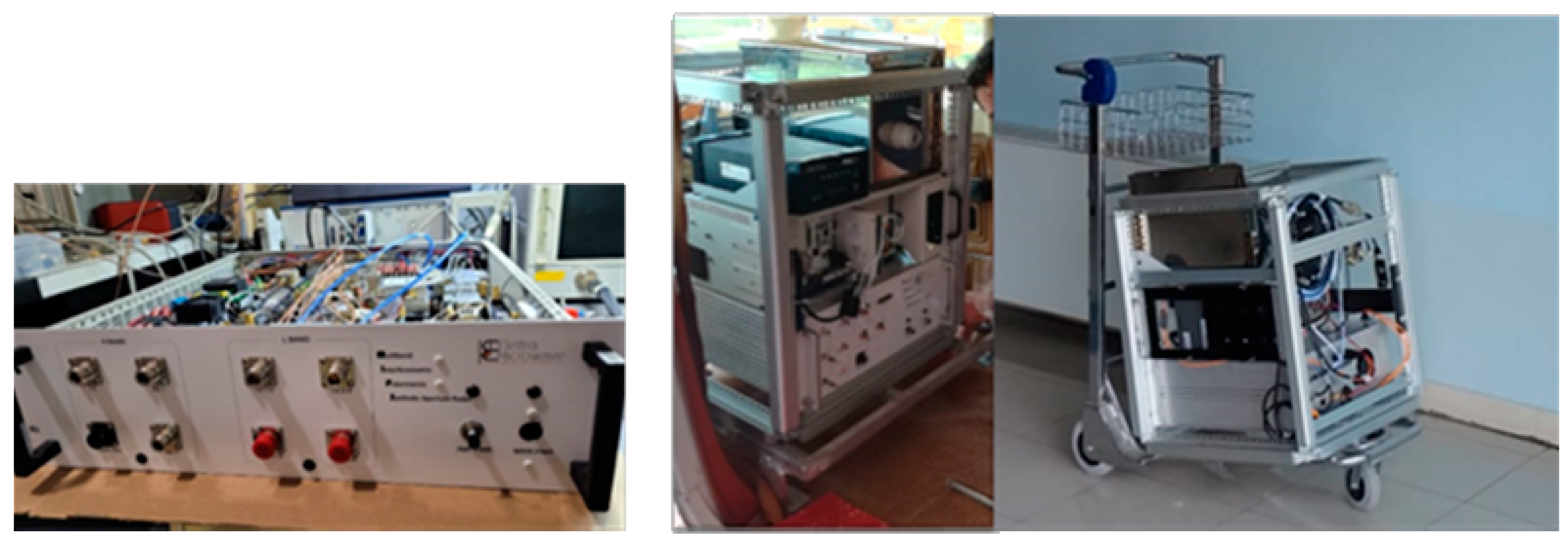


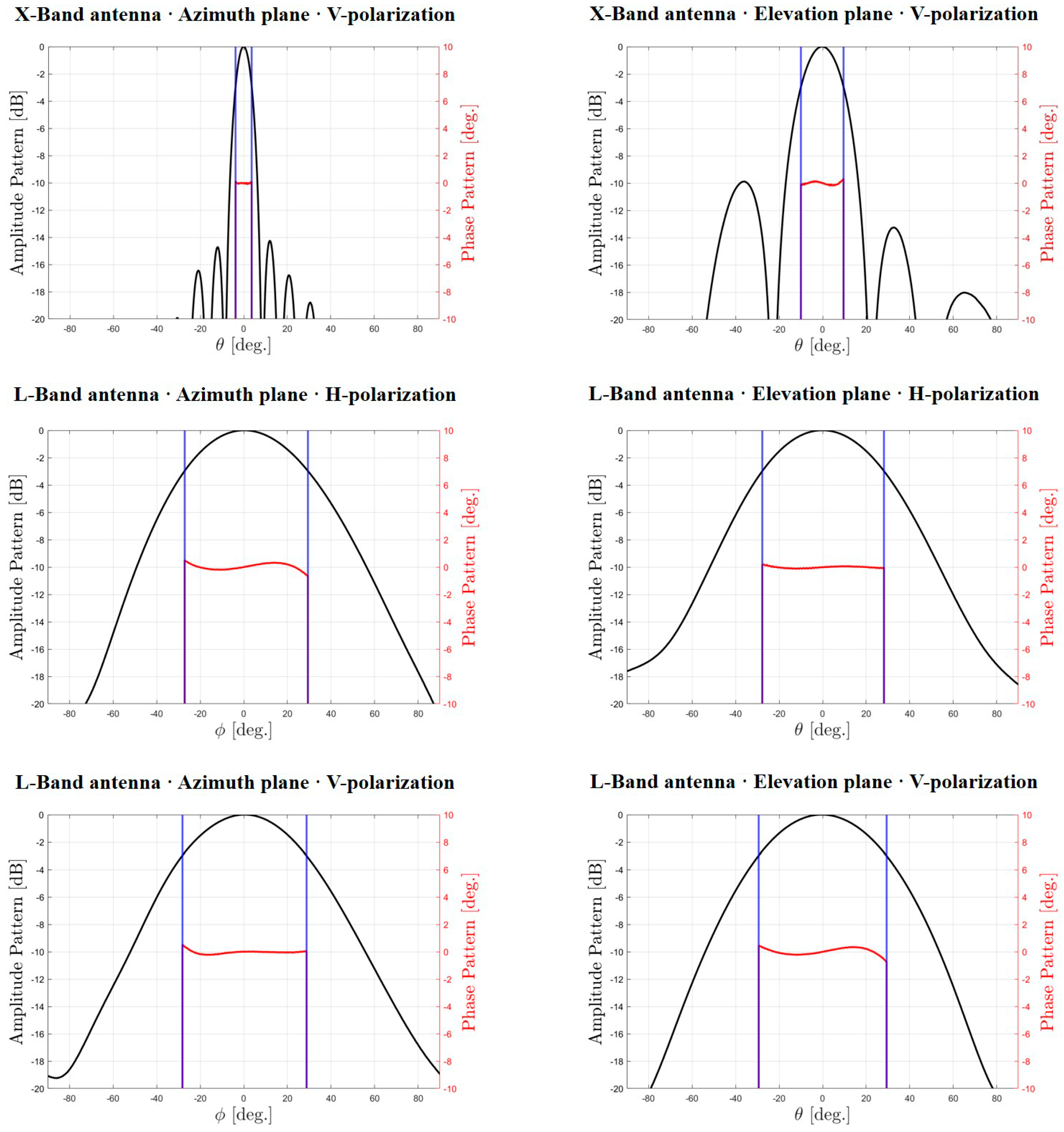



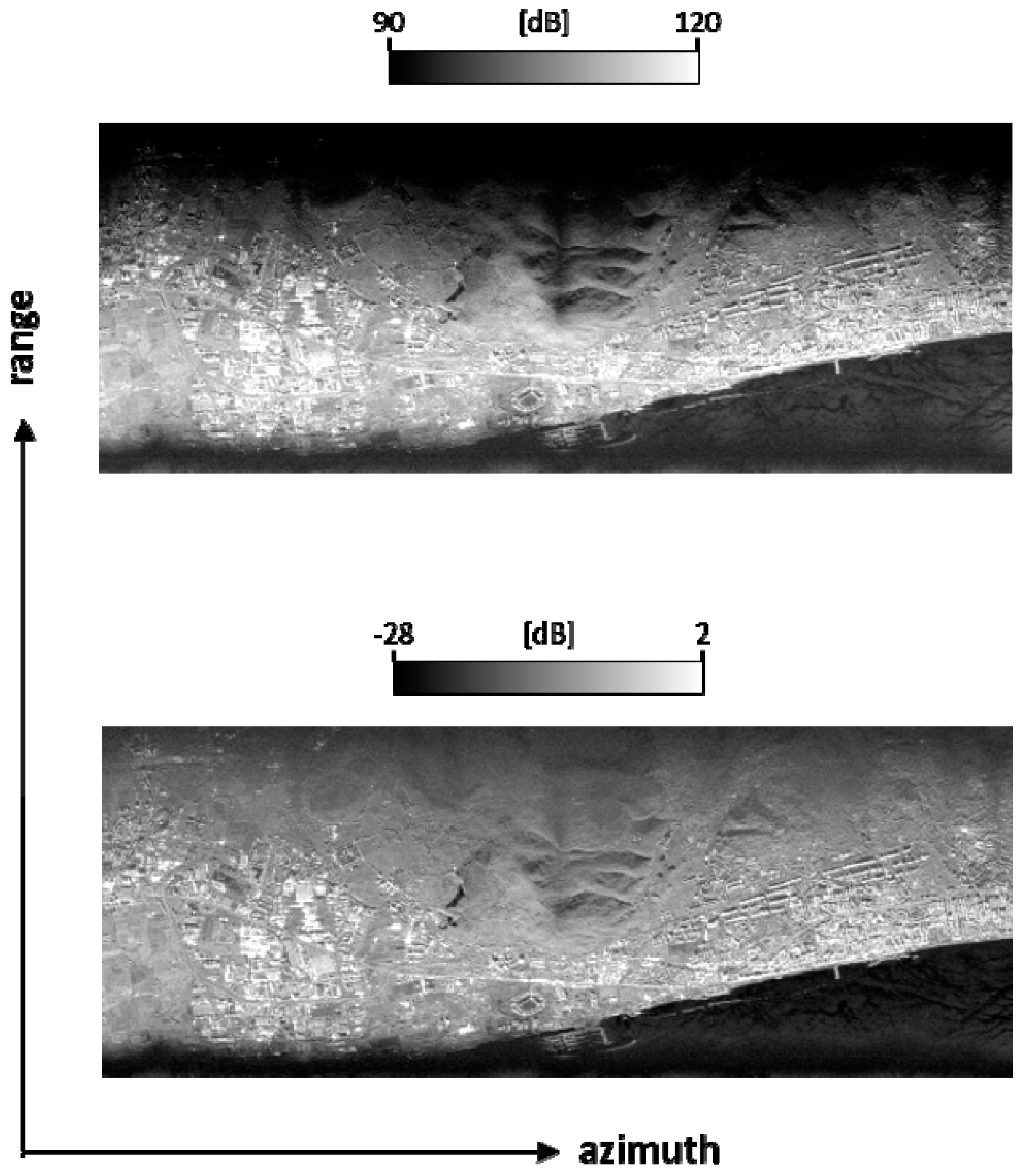
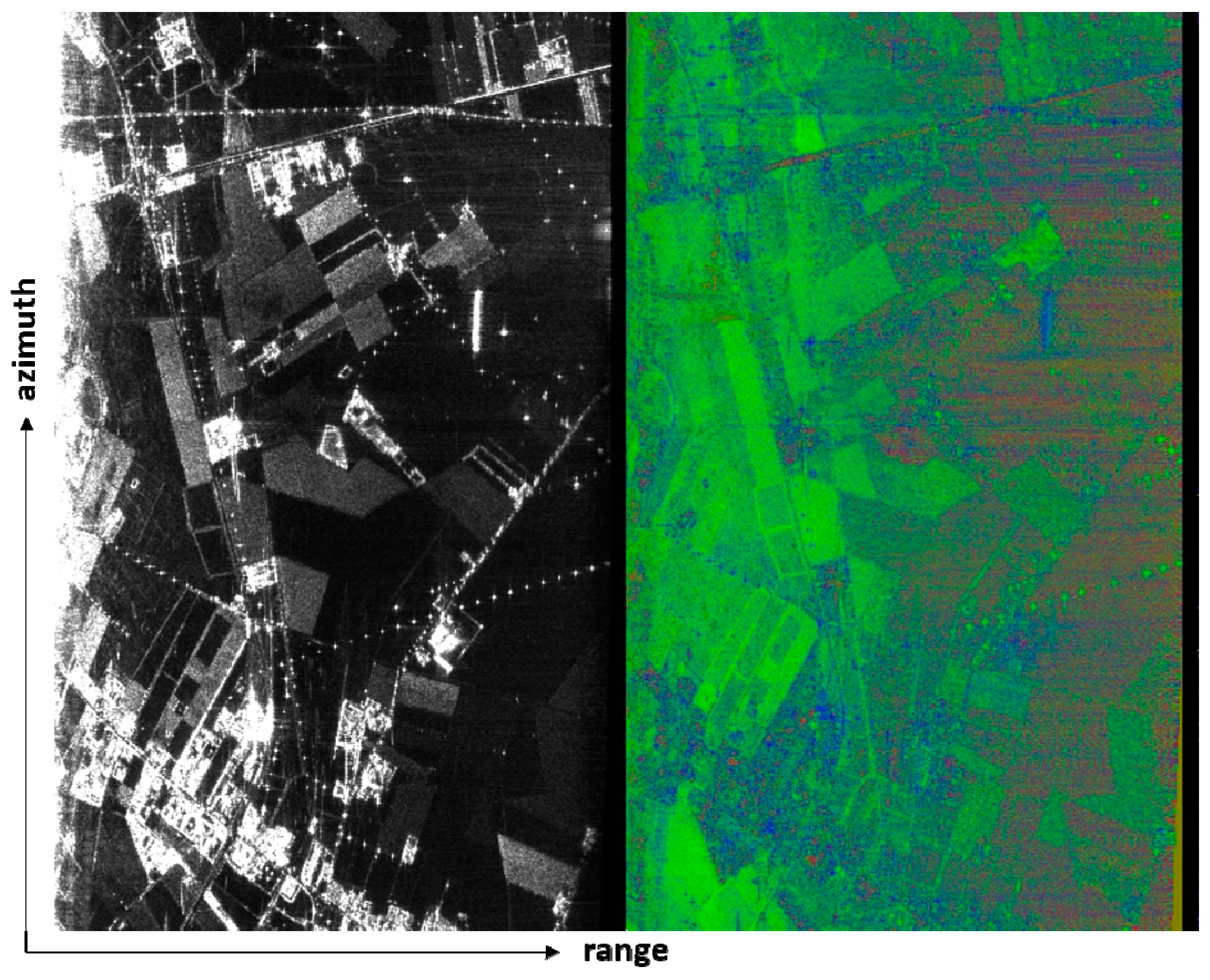




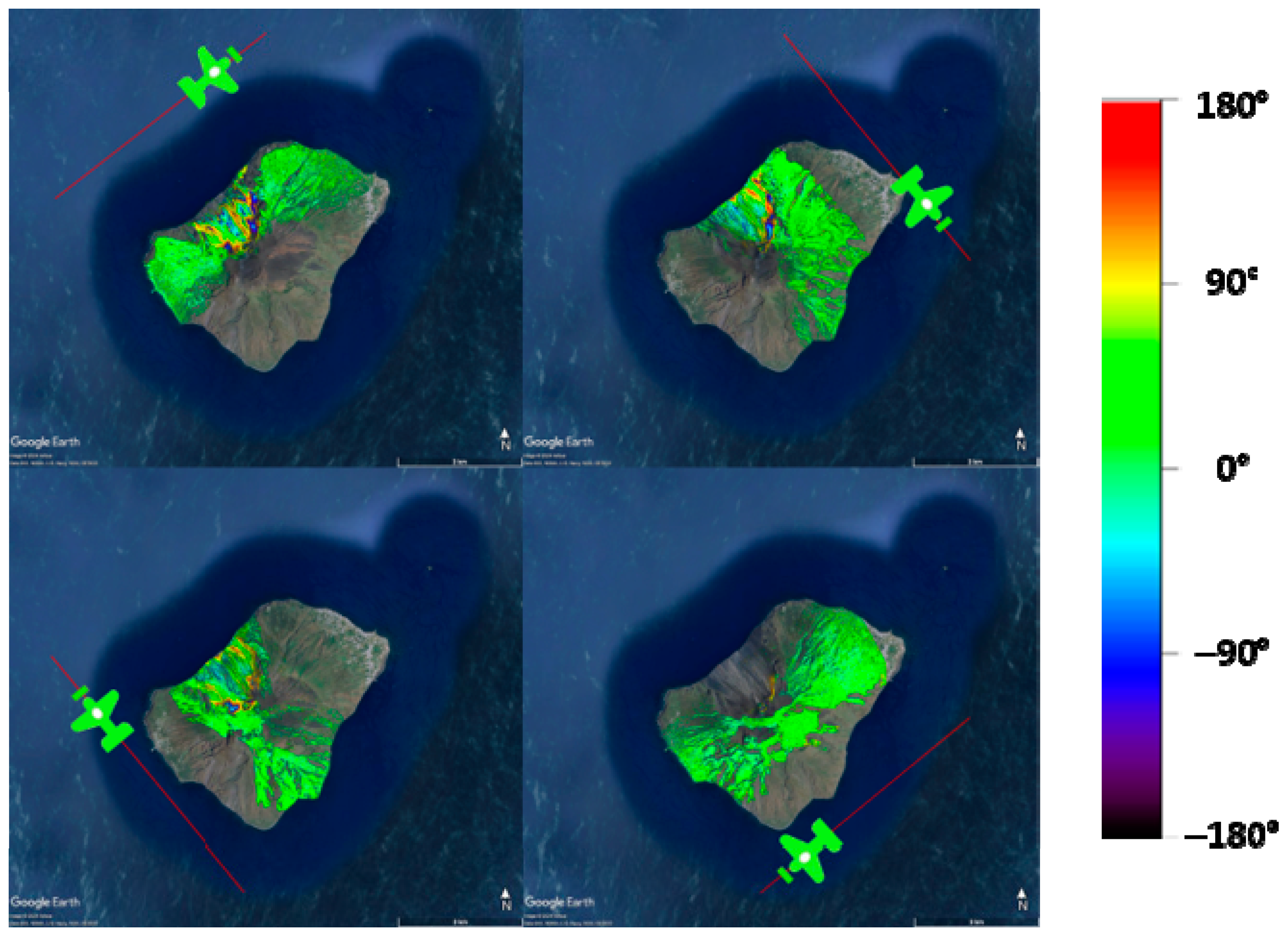
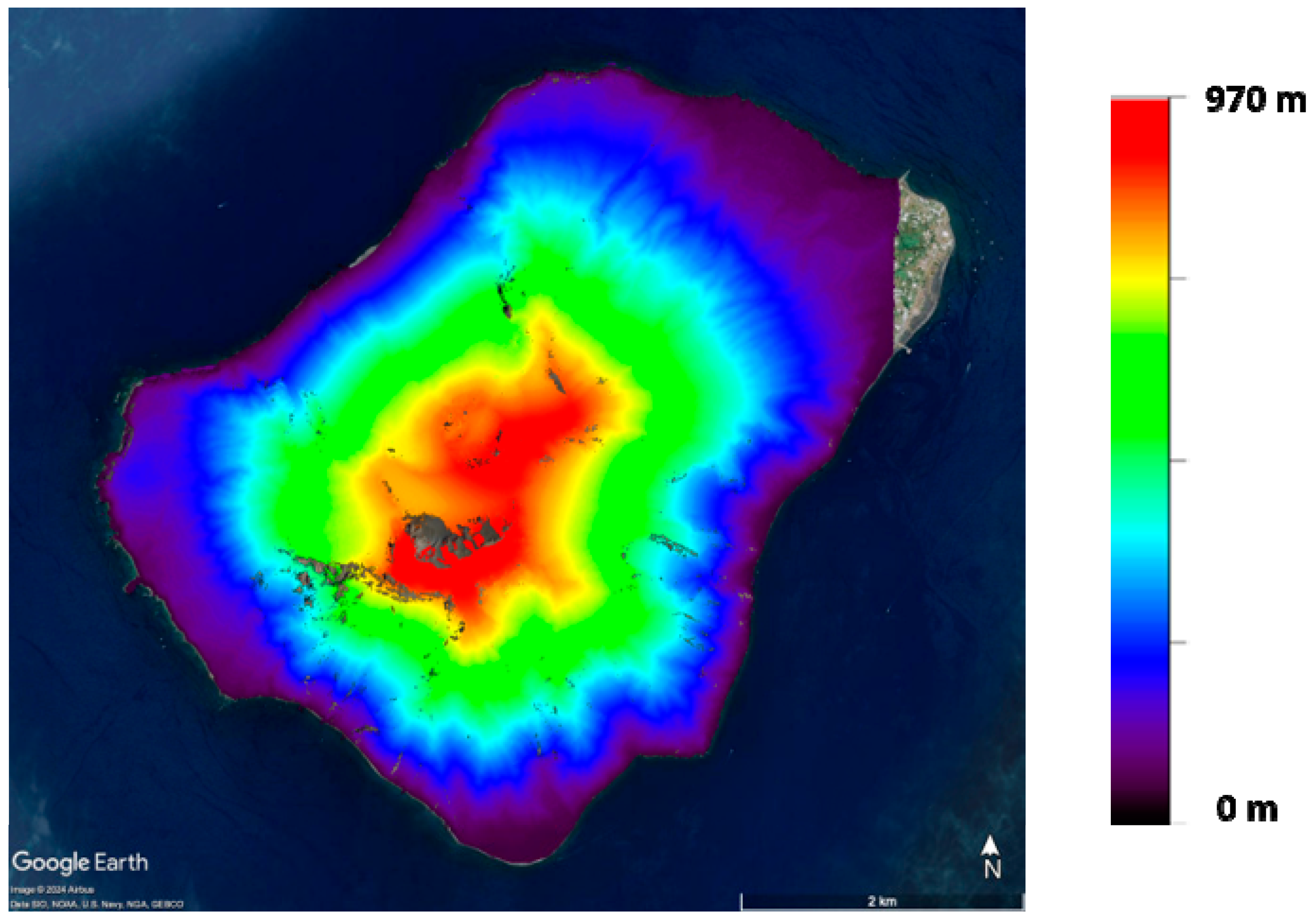
| Band | X | L |
|---|---|---|
| Technology | FMCW | FMCW |
| Chirp duration [μs] | 600.184 | 700 |
| Carrier frequency [GHz] | 9.55 | 1.35 |
| Bandwidth [MHz] | 200 | 125 |
| Number of TX antennas | 1 | 2 |
| Number of RX antennas | 2 | 2 |
| PRF [Hz] | 1200 | 600 |
| Radar rack size [cm] | 50 × 50 × 65 | |
| Radar weight * [kg] | 35 | |
| Antenna size [cm] | 24 × 12 × 1.5 | 20 × 40 × 4 |
| Antenna weight [kg] | 0.5 | 1.5 |
| Polarizations | VV | VV-VH-HV-HH |
| Sampling frequency [MHz] | 25 | 25 |
| Single-pass interferometry | yes | no |
| SLC | MLC | |
|---|---|---|
| Range pixel spacing [m] | 0.75 | 1.5 |
| Range resolution [m] | 0.75 | 1.5 |
| Azimuth pixel spacing [m] | 0.04 | 2 |
| Azimuth resolution [m] | 0.27 | 2 |
| Group 1 (8 CRs) | Group 2 (8 CRs) | |||
|---|---|---|---|---|
| Mean | St. dev. | Mean | St. dev. | |
| Range resolution [cm] | 74.0 | 1 | 73.4 | 1.2 |
| Azimuth resolution [cm] | 27.5 | 0.2 | 27.5 | 0.6 |
Disclaimer/Publisher’s Note: The statements, opinions and data contained in all publications are solely those of the individual author(s) and contributor(s) and not of MDPI and/or the editor(s). MDPI and/or the editor(s) disclaim responsibility for any injury to people or property resulting from any ideas, methods, instructions or products referred to in the content. |
© 2024 by the authors. Licensee MDPI, Basel, Switzerland. This article is an open access article distributed under the terms and conditions of the Creative Commons Attribution (CC BY) license (https://creativecommons.org/licenses/by/4.0/).
Share and Cite
Esposito, C.; Natale, A.; Lanari, R.; Berardino, P.; Perna, S. On the Capabilities of the IREA-CNR Airborne SAR Infrastructure. Remote Sens. 2024, 16, 3704. https://doi.org/10.3390/rs16193704
Esposito C, Natale A, Lanari R, Berardino P, Perna S. On the Capabilities of the IREA-CNR Airborne SAR Infrastructure. Remote Sensing. 2024; 16(19):3704. https://doi.org/10.3390/rs16193704
Chicago/Turabian StyleEsposito, Carmen, Antonio Natale, Riccardo Lanari, Paolo Berardino, and Stefano Perna. 2024. "On the Capabilities of the IREA-CNR Airborne SAR Infrastructure" Remote Sensing 16, no. 19: 3704. https://doi.org/10.3390/rs16193704







